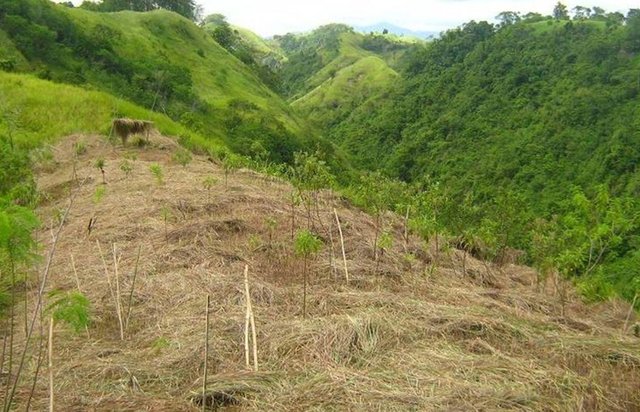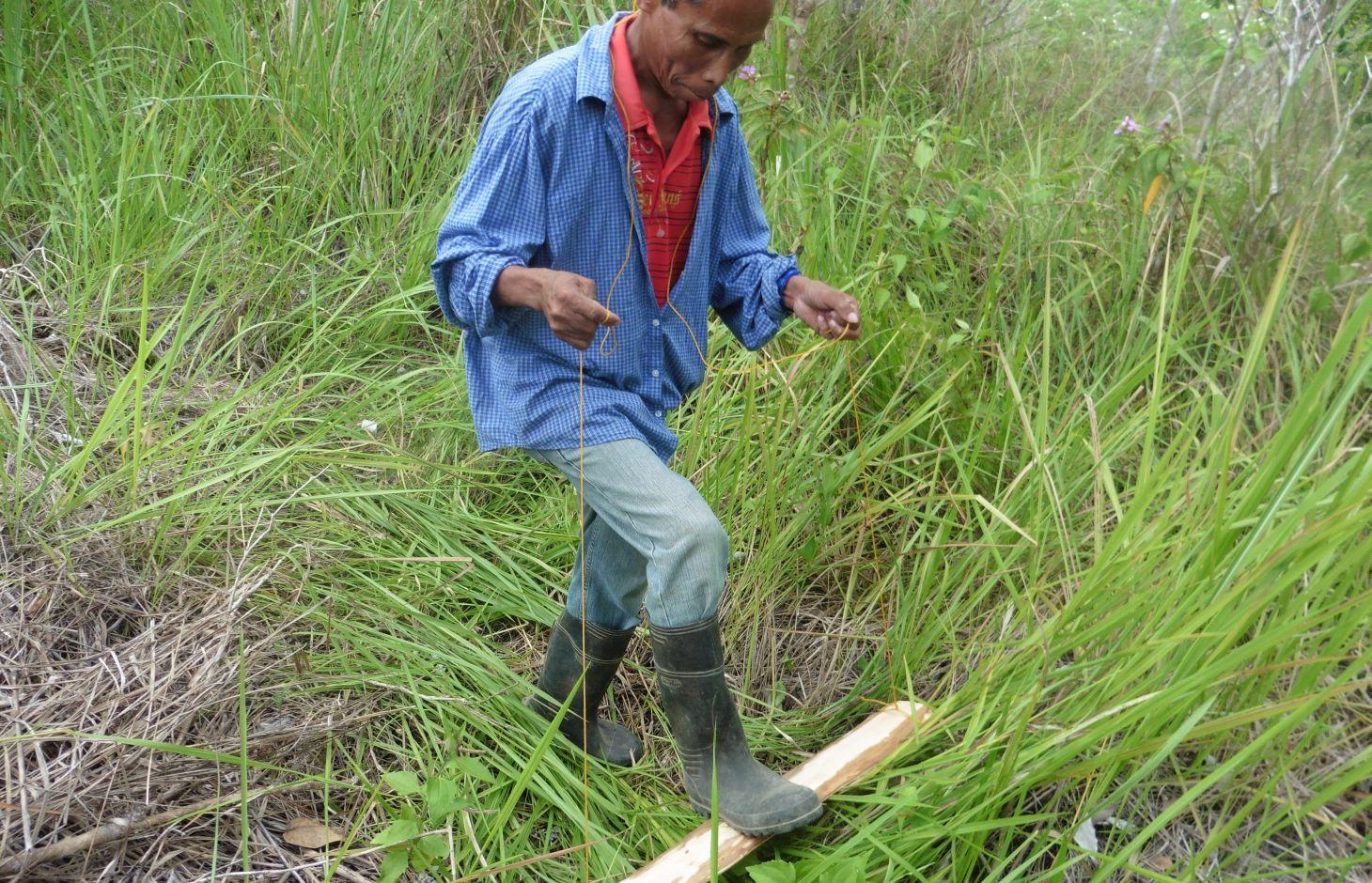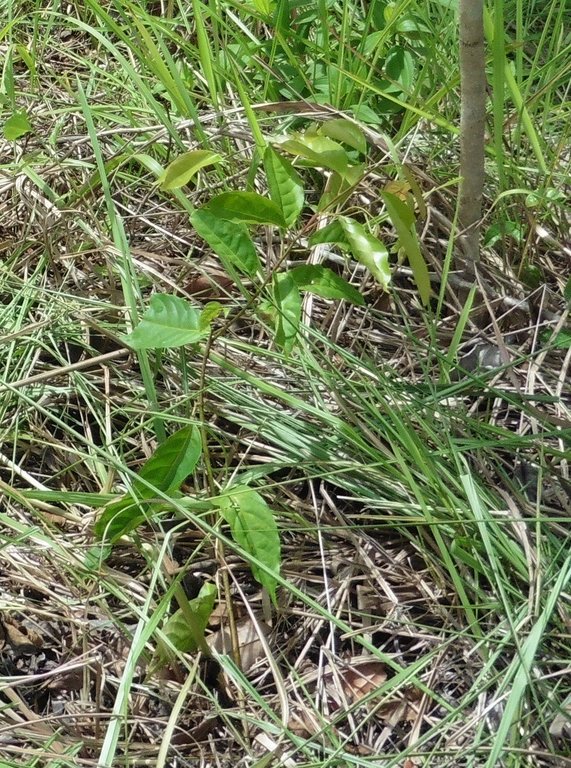Pressing of Cogon Grass (Imperata cylindrica) [Philippines]
- Creation:
- Update:
- Compiler: Philippine Overview of Conservation Approaches and Technologies
- Editor: –
- Reviewers: Fabian Ottiger, Alexandra Gavilano
technologies_1729 - Philippines
View sections
Expand all Collapse all1. General information
1.2 Contact details of resource persons and institutions involved in the assessment and documentation of the Technology
Key resource person(s)
SLM specialist:
Padilla Alberto
Danao Municipality, Local Government Unit
Philippines
SLM specialist:
Dacumos Evangeline
Department of Agriculture-Bureau of Soils and Water Management
Philippines
SLM specialist:
Espanto Patrick Benson
Department of Agriculture-Bureau of Soils and Water Management
Philippines
SLM specialist:
Dinamling Djolly Ma
Department of Agriculture-Bureau of Soils and Water Management
Philippines
SLM specialist:
Castillo Forester Emma
Department of Environment and Natural Resources-Forest Management Bureau
Philippines
Name of the institution(s) which facilitated the documentation/ evaluation of the Technology (if relevant)
Danao Municipality - PhilippinesName of the institution(s) which facilitated the documentation/ evaluation of the Technology (if relevant)
Bureau of Soils and Water Management (Bureau of Soils and Water Management) - PhilippinesName of the institution(s) which facilitated the documentation/ evaluation of the Technology (if relevant)
Forest Management Bureau (Forest Management Bureau) - Philippines1.3 Conditions regarding the use of data documented through WOCAT
The compiler and key resource person(s) accept the conditions regarding the use of data documented through WOCAT:
Yes
1.5 Reference to Questionnaire(s) on SLM Approaches (documented using WOCAT)

Assisted Natural Regeneration (ANR) [Philippines]
A process of rehabilitating degraded forest lands by taking advantage of trees already growing in the area.
- Compiler: Philippine Overview of Conservation Approaches and Technologies
2. Description of the SLM Technology
2.1 Short description of the Technology
Definition of the Technology:
An indigenous technology of enhancing wildling growth by pressing of cogon grass.
2.2 Detailed description of the Technology
Description:
Cogon pressing is a simple low-cost technique of deterring the rapid growth of grasses that serve as competitors of wildlings for nutrient, water and light in the natural forest. The technology is described as the pressing down of cogon grass using a wooden plank tied in a rope, manually-operated by foot of the land user. Instead of cutting or burning the cogon, this technology is being used by the land user it was proven to be more effective in controlling cogon grass to grow fast. Wildlings are seedlings derived from seeds scattered by birds, insects, animals and wind without human intervention. By pressing the cogon, the wildlings can grow faster in the natural forest.
Purpose of the Technology: Cogon grass is a weed which grows quickly. It is difficult to control due to its small seeds carried by wind and rhizomes that are very resilient even to low soil fertility and harsh environment. In regenerating wildlings in the natural forest, these invasive weeds are the main competitor for nutrients water and space. The land user's common practice is to cut or burn the cogon grass in order to plant trees. However, this cannot be done in a natural forest because it destroys the flora and fauna. Thus, the indigenous technology of pressing the cogon grass was adapted to nurture wildlings of indigenous tree species. It allows the wildlings to grow naturally by reducing the competition from weedy species. It also provides an alternative technique of controlling weeds/grasses without burning. Burning grasses release greenhouse gases to the atmosphere.
Establishment / maintenance activities and inputs: Prior to the pressing of cogon grass, the selection of wildlings for natural regeneration is done by marking it with a peg. The wildling must be a robust/healthy indigenous tree species. Ring weeding is done at least one half meter radius around the wildling. Then, the surrounding cogon grass are suppressed through a method called “ pressing” or “lodging” using a wooden plank approximately 1” x 6-12” x 3-4’. A rope is knotted on both ends of the plank and looped over the shoulder of the land user for support and ease the pressing operation. The length of the rope is adjusted according to the height of the land user. The land user holds the rope on both side to lift the plank, and then, stepping on it to press the cogon grass repeatedly. The activity is done before and after the onset of rainy season. It is best to practice the technology when the stems of the cogon grass are still soft. The pressed cogon will last up to six months before it will produce new shoot and regenerate again.
Natural / human environment: The area is part of the forest reserve in Danao, Bohol primarily intended for nature conservation and protection. It is about 100-500 m.a.s.l with moderately rolling to hilly slopes. It is under humid tropics climate with an average annual rainfall of 1500-2000 mm per year. The soil is loam, shallow depth, low fertility, with good drainage and medium water storage capacity. The area has high biodiversity as indicated by the presence of different indigenous trees and plants species, and wild birds. The land users who apply the technology are small holder farmers. They are members of a local cooperative. The population density is about 10-50 persons per sq. km. Since extraction of resources from the forest is prohibited, off-farm income is very important to the land users. Access to basic services and infrastructures are low.
2.3 Photos of the Technology
2.5 Country/ region/ locations where the Technology has been applied and which are covered by this assessment
Country:
Philippines
Region/ State/ Province:
Brgy. San Miguel
Further specification of location:
Danao, Bohol
Specify the spread of the Technology:
- evenly spread over an area
If the Technology is evenly spread over an area, specify area covered (in km2):
0.2
If precise area is not known, indicate approximate area covered:
- 0.1-1 km2
Comments:
Total area covered by the SLM Technology is 0.2 km2.
Map
×2.6 Date of implementation
If precise year is not known, indicate approximate date:
- more than 50 years ago (traditional)
2.7 Introduction of the Technology
Specify how the Technology was introduced:
- as part of a traditional system (> 50 years)
Comments (type of project, etc.):
The technology was introduced through the Assisted Natural Regeneration (ANR) Project.
3. Classification of the SLM Technology
3.2 Current land use type(s) where the Technology is applied

Forest/ woodlands
- Deforested land
Products and services:
- Nature conservation/ protection
- Protection against natural hazards
- Increase in biodiversity
Comments:
Major land use problems (compiler’s opinion): Competition with speedy species and recurring disturbances such as fire
Other type of forest: Deforested land
Forest products and services: nature conservation / protection, protection against natural hazards
Other forest products and services: increase biodiversity
3.5 SLM group to which the Technology belongs
- natural and semi-natural forest management
3.6 SLM measures comprising the Technology

vegetative measures
- V5: Others
Comments:
Main measures: vegetative measures
Specification of other vegetative measures: Suppressing of cogon grasses
Type of vegetative measures: scattered / dispersed
3.7 Main types of land degradation addressed by the Technology

biological degradation
- Bh: loss of habitats
- Bf: detrimental effects of fires
Comments:
Main type of degradation addressed: Bh: loss of habitats
Secondary types of degradation addressed: Bf: detrimental effects of fires
Main causes of degradation: deforestation / removal of natural vegetation (incl. forest fires), other human induced causes (specify) (fire)
3.8 Prevention, reduction, or restoration of land degradation
Specify the goal of the Technology with regard to land degradation:
- prevent land degradation
Comments:
Main goals: prevention of land degradation
4. Technical specifications, implementation activities, inputs, and costs
4.1 Technical drawing of the Technology
Technical specifications (related to technical drawing):
Pressing grass with the use of wooden board
Location: Brgy. San Miguel. Danao, Bohol
Date: June 10, 2015
Technical knowledge required for field staff / advisors: moderate
Technical knowledge required for land users: moderate (Hands-on training for land users, they should learn the craft of pressing)
Main technical functions: control of fires
Secondary technical functions: stabilisation of soil (eg by tree roots against land slides)
Scattered / dispersed
Vegetative material: T : trees / shrubs
Trees/ shrubs species: dipterocarps and indigenous species, naturally regenarated
Author:
Mr. Patricio A. Yambot, Bureau of Soils and Water Management
4.2 General information regarding the calculation of inputs and costs
other/ national currency (specify):
peso
If relevant, indicate exchange rate from USD to local currency (e.g. 1 USD = 79.9 Brazilian Real): 1 USD =:
45.0
Indicate average wage cost of hired labour per day:
4.44
4.3 Establishment activities
| Activity | Timing (season) | |
|---|---|---|
| 1. | Identification of wildlings (2 feet high) | |
| 2. | ring weeding | |
| 3. | pressing of cogon away from wildlings | 3 times/year |
| 4. | Application of fertilizer |
4.4 Costs and inputs needed for establishment
| Specify input | Unit | Quantity | Costs per Unit | Total costs per input | % of costs borne by land users | |
|---|---|---|---|---|---|---|
| Labour | Labour | ha | 1.0 | 24.44 | 24.44 | 100.0 |
| Construction material | Wood | ha | 1.0 | 2.22 | 2.22 | 100.0 |
| Construction material | Rope | ha | 1.0 | 1.78 | 1.78 | 100.0 |
| Total costs for establishment of the Technology | 28.44 | |||||
| Total costs for establishment of the Technology in USD | 0.63 | |||||
Comments:
Duration of establishment phase: 3 month(s)
4.5 Maintenance/ recurrent activities
| Activity | Timing/ frequency | |
|---|---|---|
| 1. | Pressing of Cogon | every other month |
4.6 Costs and inputs needed for maintenance/ recurrent activities (per year)
| Specify input | Unit | Quantity | Costs per Unit | Total costs per input | % of costs borne by land users | |
|---|---|---|---|---|---|---|
| Labour | Labour | ha | 1.0 | 26.68 | 26.68 | 100.0 |
| Total costs for maintenance of the Technology | 26.68 | |||||
| Total costs for maintenance of the Technology in USD | 0.59 | |||||
5. Natural and human environment
5.1 Climate
Annual rainfall
- < 250 mm
- 251-500 mm
- 501-750 mm
- 751-1,000 mm
- 1,001-1,500 mm
- 1,501-2,000 mm
- 2,001-3,000 mm
- 3,001-4,000 mm
- > 4,000 mm
Agro-climatic zone
- humid
Thermal climate class: tropics
5.2 Topography
Slopes on average:
- flat (0-2%)
- gentle (3-5%)
- moderate (6-10%)
- rolling (11-15%)
- hilly (16-30%)
- steep (31-60%)
- very steep (>60%)
Landforms:
- plateau/plains
- ridges
- mountain slopes
- hill slopes
- footslopes
- valley floors
Altitudinal zone:
- 0-100 m a.s.l.
- 101-500 m a.s.l.
- 501-1,000 m a.s.l.
- 1,001-1,500 m a.s.l.
- 1,501-2,000 m a.s.l.
- 2,001-2,500 m a.s.l.
- 2,501-3,000 m a.s.l.
- 3,001-4,000 m a.s.l.
- > 4,000 m a.s.l.
Comments and further specifications on topography:
Altitudinal zone: 101-500 m a.s.l. (220m)
5.3 Soils
Soil depth on average:
- very shallow (0-20 cm)
- shallow (21-50 cm)
- moderately deep (51-80 cm)
- deep (81-120 cm)
- very deep (> 120 cm)
Soil texture (topsoil):
- medium (loamy, silty)
Topsoil organic matter:
- medium (1-3%)
If available, attach full soil description or specify the available information, e.g. soil type, soil PH/ acidity, Cation Exchange Capacity, nitrogen, salinity etc.
Soil fertility is: Medium
Soil water storage capacity is: Medium
5.4 Water availability and quality
Availability of surface water:
medium
5.5 Biodiversity
Species diversity:
- high
5.6 Characteristics of land users applying the Technology
Market orientation of production system:
- subsistence (self-supply)
Off-farm income:
- > 50% of all income
Individuals or groups:
- employee (company, government)
Gender:
- women
- men
Indicate other relevant characteristics of the land users:
Land users applying the Technology are mainly common / average land users
Population density: 10-50 persons/km2
Annual population growth: 1% - 2%; 1%
Off-farm income specification: Since extraction of resources from the forest is prohibited, off- farm income is very important to the land users.
Market orientation of production system: Forest conservation. Green braks are planted with cash crops as immediate source of food for subistence.
5.7 Average area of land used by land users applying the Technology
- < 0.5 ha
- 0.5-1 ha
- 1-2 ha
- 2-5 ha
- 5-15 ha
- 15-50 ha
- 50-100 ha
- 100-500 ha
- 500-1,000 ha
- 1,000-10,000 ha
- > 10,000 ha
Is this considered small-, medium- or large-scale (referring to local context)?
- medium-scale
5.8 Land ownership, land use rights, and water use rights
Land ownership:
- state
Land use rights:
- open access (unorganized)
5.9 Access to services and infrastructure
health:
- poor
- moderate
- good
education:
- poor
- moderate
- good
technical assistance:
- poor
- moderate
- good
employment (e.g. off-farm):
- poor
- moderate
- good
markets:
- poor
- moderate
- good
energy:
- poor
- moderate
- good
roads and transport:
- poor
- moderate
- good
6. Impacts and concluding statements
6.1 On-site impacts the Technology has shown
Socio-economic impacts
Production
risk of production failure
Income and costs
workload
Socio-cultural impacts
community institutions
conflict mitigation
Improved livelihoods and human well-being
Comments/ specify:
yes little, it generated jobs
Ecological impacts
Water cycle/ runoff
surface runoff
evaporation
Soil
soil moisture
soil cover
nutrient cycling/ recharge
soil organic matter/ below ground C
Biodiversity: vegetation, animals
biomass/ above ground C
plant diversity
beneficial species
habitat diversity
Climate and disaster risk reduction
emission of carbon and greenhouse gases
fire risk
Other ecological impacts
Regeneration of indigenous species
Adaption to climate change
Accidents/injuries induced by humans
6.2 Off-site impacts the Technology has shown
damage on neighbours' fields
damage on public/ private infrastructure
6.3 Exposure and sensitivity of the Technology to gradual climate change and climate-related extremes/ disasters (as perceived by land users)
Gradual climate change
Gradual climate change
| Season | increase or decrease | How does the Technology cope with it? | |
|---|---|---|---|
| annual temperature | increase | not well |
Climate-related extremes (disasters)
Meteorological disasters
| How does the Technology cope with it? | |
|---|---|
| local rainstorm | not known |
| local windstorm | not known |
Climatological disasters
| How does the Technology cope with it? | |
|---|---|
| drought | not known |
Hydrological disasters
| How does the Technology cope with it? | |
|---|---|
| general (river) flood | not known |
Other climate-related consequences
Other climate-related consequences
| How does the Technology cope with it? | |
|---|---|
| reduced growing period | not known |
6.4 Cost-benefit analysis
How do the benefits compare with the establishment costs (from land users’ perspective)?
Short-term returns:
positive
Long-term returns:
positive
How do the benefits compare with the maintenance/ recurrent costs (from land users' perspective)?
Short-term returns:
positive
Long-term returns:
positive
6.5 Adoption of the Technology
Comments:
100% of land user families have adopted the Technology with external material support
Comments on acceptance with external material support: The Department of Environment and Natural Resources (DENR) provided financial and technical support for the implementation of the technology. The Local Government Unit (LGU) of Bohol provided additional labor force for the maintenance.
6.7 Strengths/ advantages/ opportunities of the Technology
| Strengths/ advantages/ opportunities in the compiler’s or other key resource person’s view |
|---|
|
Low cost technology How can they be sustained / enhanced? Re-use and proper safe keeping of material. |
|
Limits height of fire How can they be sustained / enhanced? Frequent regular conduct of "pressing" activity |
6.8 Weaknesses/ disadvantages/ risks of the Technology and ways of overcoming them
| Weaknesses/ disadvantages/ risks in the land user’s view | How can they be overcome? |
|---|---|
| Labor may cause some injury to workers | Extra care in conducting pressing activity particularly in steep areas |
| Increased dry matter susceptible to forest fire | Maintenance of fire lines |
| Weaknesses/ disadvantages/ risks in the compiler’s or other key resource person’s view | How can they be overcome? |
|---|---|
| Labor intensive | Thorough "pressing" of cogon grass to deter growth |
7. References and links
7.1 Methods/ sources of information
Links and modules
Expand all Collapse allLinks

Assisted Natural Regeneration (ANR) [Philippines]
A process of rehabilitating degraded forest lands by taking advantage of trees already growing in the area.
- Compiler: Philippine Overview of Conservation Approaches and Technologies
Modules
No modules





